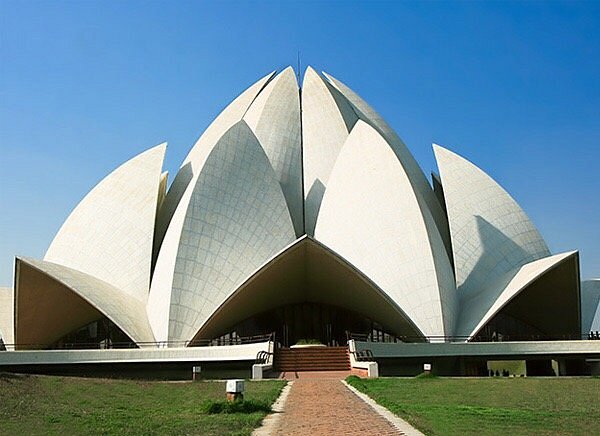Lotus Temple, Delhi – A Symbol of Peace and Unity
The Lotus Temple, one of Delhi’s most iconic landmarks, is a stunning architectural marvel and a serene spiritual sanctuary. Located in the Bahapur area near Nehru Place in South Delhi, this Bahá’í House of Worship is renowned for its flowerlike shape, symbolizing purity, peace, and tranquility. Since its completion in 1986, the Lotus Temple has drawn millions of visitors from across the world, both for its unique design and its spiritual ambiance.
Architectural Brilliance
Designed by Iranian-American architect Fariborz Sahba, the Lotus Temple is shaped like a blooming white lotus, a flower that holds deep significance in Indian culture and religions. The structure is made of white Greek marble and consists of 27 free-standing petals arranged in clusters of three to form nine sides. The temple stands amidst lush green gardens and is surrounded by nine reflecting pools, enhancing its ethereal beauty and creating a peaceful environment.
The temple’s design has won numerous architectural awards and has been featured in many architectural journals and documentaries. It’s often compared to the Sydney Opera House due to its futuristic and organic form. The symmetry and balance in its design, coupled with its minimalist aesthetics, make it a masterpiece of modern architecture.
Spiritual Significance
The Lotus Temple is a Bahá’í House of Worship, open to people of all religions, faiths, and backgrounds. The Bahá’í Faith, founded in the 19th century, emphasizes the unity of all religions and the oneness of humanity. The temple reflects these ideals—there are no idols, pictures, or religious symbols inside. Instead, visitors are invited to sit in silent meditation or prayer, irrespective of their beliefs.
Scriptures from all major world religions—such as the Bible, Quran, Gita, and others—can be read or chanted inside, but no sermons or ritualistic ceremonies are held. The emphasis is on personal reflection and inner peace. This inclusiveness and openness are what make the Lotus Temple not just a religious site, but a symbol of global unity and harmony.
Visitor Experience
The moment visitors step into the premises, they are enveloped by a sense of calm. The walkways through the gardens, the gentle breeze over the water pools, and the silence of the prayer hall offer a welcome respite from the hustle and bustle of Delhi. The temple can accommodate around 2,500 people at a time, and the silence inside the central hall is deeply moving, encouraging visitors to disconnect from the outside world and turn inward.
There is also an Information Center on the temple grounds where visitors can learn about the Bahá’í Faith, the temple’s history, and its architectural design through exhibitions, documentaries, and literature.
Visiting Hours and Entry
The Lotus Temple is open Tuesday to Sunday (closed on Mondays). The usual visiting hours are from 9:00 AM to 5:00 PM in winter and up to 7:00 PM in summer. Entry to the temple is free of charge.
Since it’s a popular tourist attraction, it’s best to visit early in the morning or during weekdays to avoid large crowds. Photography is allowed outside the temple, but not inside the prayer hall to maintain the sanctity and silence of the space.
Eco-Friendly Design
Interestingly, the Lotus Temple is also notable for its eco-friendly construction. The temple utilizes natural light during the day, reducing energy consumption. Its design allows for natural ventilation, and the surrounding pools help regulate the temperature, making the structure not just beautiful but also environmentally conscious.
